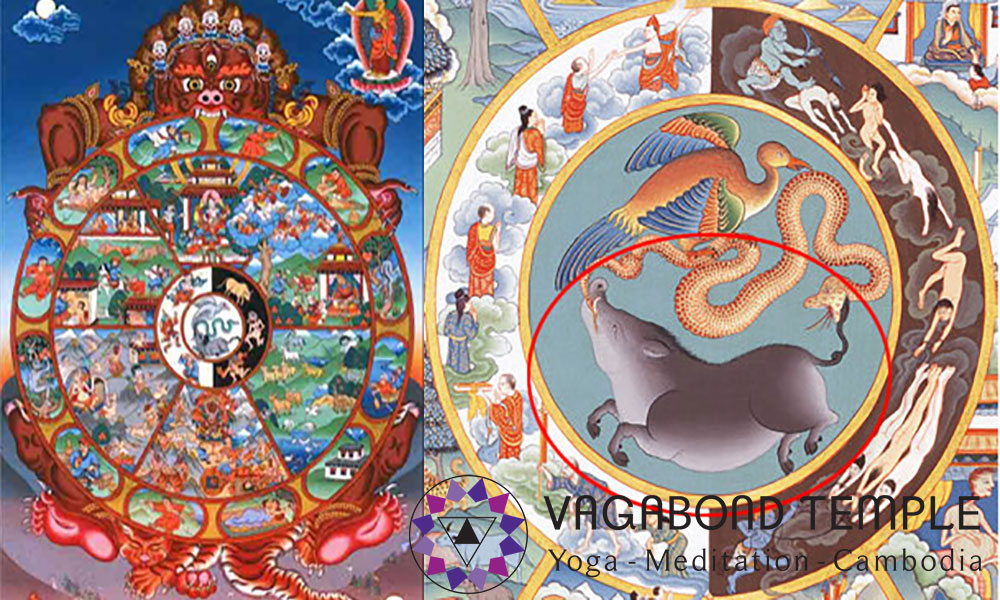Why This Little Pig Is The Source of All The Pain And Suffering In The World

The image above is detail from the centre of the Wheel of Life, the iconic Tibetan Buddhist image which depicts the cyclical nature of the lives of all living beings. The image provides a visual representation of the entire Buddhist world-view, with concepts such as Karma, Rebirth, Suffering and Enlightenment depicted with various visual metaphors.
Right at the centre of the wheel is usually depicted a pig, a chicken, and a snake. The positioning can vary but in the image above we see that the pig has both the feathers of the chicken and the tail of the snake in its mouth. So not only is the pig the dominant character in the scene, but the scene itself is at the centre of the entire wheel. So it is evident that this pig really is central to the Buddhist philosophy.
In Buddhism, the everyday world in which we find ourselves is viewed as unsatisfactory. We constantly strive to improve our situation, but are only ever able to find temporary happiness. In our modern society it is easy to see this: many of us believe that happiness will come with a new job, a new partner, a new house etc. but once we acquire the object of our desire, before long the feeling wears off and we return to our dissatisfied state. On a more fundamental level, life can seem meaningless as throughout all of our striving we know deep down that we will eventually die and lose everything.
Rather than being a depressing outlook, the Buddhist view is actually one of hope, because it teaches us how to find true happiness – that is which is not dependent on the temporary and ever-changing objects, people, and situations of daily life.
So Why The Pig?
If we wish to escape from a situation, it is helpful to know what is causing it in the first place. In this way Buddhism first teaches us the cause of the unsatisfactory nature of the world. The primary cause is ignorance: represented by the pig at the centre of the wheel. Ignorance is our failure to see the true essence of things; we cling to temporary things as if they are solid; we believe that happiness will come from external objects. Ignorance also leads us to identify with our thoughts, believing the stories they tell us without question – failing to examine their origins and whether or not they actually serve us.
Our mind is the most powerful tool we have, but if we do not learn to control it, it will control us. Imagine digging a hole with a shovel and suddenly realising that the shovel is doing the digging and you are unable to stop. This is how the mind is for many of us – our thoughts lead us blindly into the same old unhelpful patterns. Ignorance is what causes this loss of control. It can also be thought of as the gap between our perception and the true nature of things; or between our expectations and reality. We can even bring this to the spiritual path if we are not careful. For example, having the belief that if we meditate everything will be OK could be problematic as we will be disappointed when this turns out not to be the case.
In our lives we play many roles: we may be a husband or wife, teacher or student, employee or manager etc. However defining ourselves in this way is a form of ignorance, it limits us and we miss our true essence. In the Buddhist philosophy, even identifying with our bodies and thoughts is a form of ignorance because they are temporary and ever-changing, and our true essence is something else.
What About The Chicken And The Snake?
Ignorance is one of the three poisons identified by Buddhism; the other two being attachment (represented by the Chicken in the Wheel of Life) and Aversion (the Snake). The Chicken and the Snake are in the jaws of the pig, demonstrating how ignorance is the cause of the other two poisons.
It is easy to see how ignorance creates attachment. If we are ignorant about the true nature of the mind we will believe in that external objects can make us happy. We will think, “when I get this new job/car/house/partner/etc. I will be happy”. So we become attached to something temporary, clinging to it as if it was solid: we will regret it if we do not obtain it, if we lose it we will resent its absence. If we get the object we desire, the happiness we get from it will be temporary and we will have strengthened our tendency to depend on external things, leading to future dissatisfaction.
In the same way, ignorance leads to aversion. If we desire something that we do not have, we may become jealous of a person who has it – which can drive us even to hatred. If we are attached to external circumstances we will be lost in regret with thoughts like, “If my partner did not leave me, I would be happy”. This causes us to fight against ourselves, rejecting or suppressing our experiences instead of using them as an opportunity for spiritual growth.
In the deepest sense, ignorance is the idea that we are separate from the world, that we have a fixed “self” independent from everything else. It is the identification with this self that brings us suffering. Even the suffering associated with sickness and death itself comes from our attachment to our bodies which arises from our ignorance of our true nature. In this way ignorance is said to give rise to all the pain and suffering in the world.
Escaping The Cycle
In the Buddhist tradition, ignorance can be overcome by “right-mindfulness”. By using techniques such as silent meditation, we can place our thoughts under the microscope and see them for what they are. We can learn not to identify with the mind, body and external objects and reduce the power they hold over us, enabling us to take control of our lives. On the deepest level, dropping ignorance will dispel the illusion that we are separate from the world, bringing us into a state of unity.



